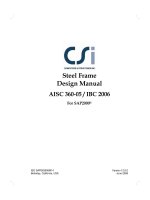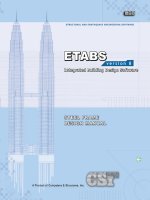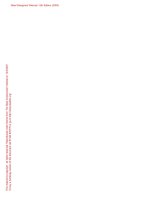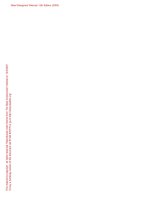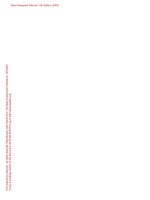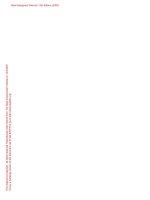Steel Frame Design Manual
Bạn đang xem bản rút gọn của tài liệu. Xem và tải ngay bản đầy đủ của tài liệu tại đây (3.63 MB, 206 trang )
Steel Frame
Design Manual
ETABS
®
Integrated
Three Dimensional
Static and Dynamic Analysis and Design
of
Building Systems
STEEL FRAME DESIGN MANUAL
Computers and Structures, Inc.
Berkeley, California, USA
Version 7.0
October 2000
COPYRIGHT
The computer program ETABS and all associated documentation are
proprietary and copyrighted products. Worldwide rights of ownership
rest with Computers and Structures, Inc. Unlicensed use of the program
or reproduction of the documentation in any form, without prior written
authorization from Computers and Structures, Inc., is explicitly prohib
-
ited.
Further information and copies of this documentation may be obtained
from:
Computers and Structures, Inc.
1995 University Avenue
Berkeley, California 94704 USA
Tel: (510) 845-2177
Fax: (510) 845-4096
E-mail:
Web: www.csiberkeley.com
© Copyright Computers and Structures, Inc., 1978–2000.
The CSI Logo is a registered trademark of Computers and Structures, Inc.
ETABS is a registered trademark of Computers and Structures, Inc.
DISCLAIMER
CONSIDERABLE TIME, EFFORT AND EXPENSE HAVE GONE
INTO THE DEVELOPMENT AND DOCUMENTATION OF ETABS.
THE PROGRAM HAS BEEN THOROUGHLY TESTED AND USED.
IN USING THE PROGRAM, HOWEVER, THE USER ACCEPTS
AND UNDERSTANDS THAT NO WARRANTY IS EXPRESSED OR
IMPLIED BY THE DEVELOPERS OR THE DISTRIBUTORS ON
THE ACCURACY OR THE RELIABILITY OF THE PROGRAM.
THIS PROGRAM IS A VERY PRACTICAL TOOL FOR THE DE
-
SIGN/ CHECK OF STEEL STRUCTURES. HOWEVER, THE USER
MUST THOROUGHLY READ THE MANUAL AND CLEARLY
RECOGNIZE THE ASPECTS OF STEEL DESIGN THAT THE PRO-
GRAM ALGORITHMS DO NOT ADDRESS.
THE USER MUST EXPLICITLY UNDERSTAND THE ASSUMP-
TIONS OF THE PROGRAM AND MUST INDEPENDENTLY VER-
IFY THE RESULTS.
Table of Contents
CHAPTER I Introduction 1
Overview 1
Organization 3
Recommended Reading 4
CHAPTER II Design Algorithms 5
Design Load Combinations 6
Design and Check Stations 8
P-
Effects 8
Element Unsupported Lengths 9
Effective Length Factor (K) 11
Design of Continuity Plates 13
Design of Doubler Plates 15
Choice of Input Units 17
CHAPTER III Check/Design for AISC-ASD89 19
Design Loading Combinations 22
Classification of Sections 22
Calculation of Stresses 26
Calculation of Allowable Stresses 27
Allowable Stress in Tension 27
Allowable Stress in Compression 27
Flexural Buckling 27
Flexural-Torsional Buckling 29
Allowable Stress in Bending 34
I-sections 34
Channel sections 37
T-sections and Double angles 38
i
Box Sections and Rectangular Tubes 39
Pipe Sections 40
Round Bars 40
Rectangular and Square Bars 40
Single-Angle Sections 41
General Sections 43
Allowable Stress in Shear 43
Calculation of Stress Ratios 44
Axial and Bending Stresses 45
Shear Stresses 47
CHAPTER IV Check/Design for AISC-LRFD93 49
Design Loading Combinations 52
Classification of Sections 52
Calculation of Factored Forces 56
Calculation of Nominal Strengths 58
Compression Capacity 58
Flexural Buckling 58
Flexural-Torsional Buckling 62
Torsional and Flexural-Torsional Buckling 62
Tension Capacity 64
Nominal Strength in Bending 65
Yielding 65
Lateral-Torsional Buckling 65
Flange Local Buckling 69
Web Local Buckling 73
Shear Capacities 76
Calculation of Capacity Ratios 77
Axial and Bending Stresses 77
Shear Stresses 78
CHAPTER V Check/Design for UBC-ASD97 79
Design Loading Combinations 81
Member Design 82
Classification of Sections 82
Calculation of Stresses 84
Calculation of Allowable Stresses 84
Calculation of Stress Ratios 85
Axial and Bending Stresses 85
Shear Stresses 87
Seismic Requirements 88
Ordinary Moment Frames 88
Special Moment-Resisting Frames 88
Braced Frames 89
Eccentrically Braced Frames 90
Special Concentrically Braced Frames 93
ii
ETABS Steel Design Manual
Joint Design 94
Design of Continuity Plates 95
Design of Doubler Plates 98
Beam/Column Plastic Moment Capacity Ratio 100
Evaluation of Beam Connection Shears 102
Evaluation of Brace Connection Forces 103
CHAPTER VI Check/Design for UBC-LRFD97 105
Design Loading Combinations 107
Member Design 108
Classification of Sections 108
Calculation of Factored Forces 110
Calculation of Nominal Strengths 111
Calculation of Capacity Ratios 112
Axial and Bending Stresses 112
Shear Stresses 113
Seismic Requirements 114
Ordinary Moment Frames 114
Special Moment-Resisting Frames 114
Braced Frames 115
Eccentrically Braced Frames 116
Special Concentrically Braced Frames 119
Joint Design 121
Design of Continuity Plates 121
Design of Doubler Plates 125
Weak Beam Strong Column Measure 128
Evaluation of Beam Connection Shears 129
Evaluation of Brace Connection Forces 130
CHAPTER VII Check/Design for CISC94 133
Design Loading Combinations 136
Classification of Sections 137
Calculation of Factored Forces 137
Calculation of Factored Strengths 140
Compression Strength 140
Tension Strength 141
Bending Strengths 141
I-shapes and Boxes 142
Rectangular Bar 143
Pipes and Circular Rods 143
Channel Sections 144
T-shapes and double angles 144
Single Angle and General Sections 145
Shear Strengths 145
Calculation of Capacity Ratios 147
iii
Table of Contents
Axial and Bending Stresses 147
Shear Stresses 150
CHAPTER VIII Check/Design for BS 5950 151
Design Loading Combinations 154
Classification of Sections 155
Calculation of Factored Forces 157
Calculation of Section Capacities 159
Compression Resistance 159
Tension Capacity 161
Moment Capacity 161
Plastic and Compact Sections 161
Semi-compact Sections 162
Lateral-Torsional Buckling Moment Capacity 162
Shear Capacities 165
Calculation of Capacity Ratios 165
Local Capacity Check 167
Under Axial Tension 167
Under Axial Compression 167
Overall Buckling Check 167
Shear Capacity Check 168
CHAPTER IX Check/Design for EUROCODE 3 169
Design Loading Combinations 172
Classification of Sections 173
Calculation of Factored Forces 177
Calculation of Section Resistances 178
Tension Capacity 179
Compression Resistance 179
Shear Capacity 181
Moment Resistance 182
Lateral-torsional Buckling 183
Calculation of Capacity Ratios 185
Bending, Axial Compression, and Low Shear 185
Bending, Axial Compression, and High Shear 186
Bending, Compression, and Flexural Buckling 186
Bending, Compression, and Lateral-Torsional Buckling 187
Bending, Axial Tension, and Low Shear 188
Bending, Axial Tension, and High Shear 188
Bending, Axial Tension, and Lateral-Torsional Buckling 189
Shear 189
CHAPTER X Design Output 191
Overview 191
iv
ETABS Steel Design Manual
Graphical Display of Design Input and Output 192
Tabular Display of Design Input and Output 193
Member Specific Information 195
References 197
Index 199
v
Table of Contents
Chapter I
Introduction
Overview
ETABS features powerful and completely integrated modules for design of both
steel and reinforced concrete structures. The program provides the user with op-
tions to create, modify, analyze and design structural models, all from within the
same user interface. The program is capable of performing initial member sizing
and optimization from within the same interface.
The program provides an interactive environment in which the user can study the
stress conditions, make appropriate changes, such as revising member properties,
and re-examine the results without the need to re-run the analysis. A single mouse
click on an element brings up detailed design information. Members can be
grouped together for design purposes. The output in both graphical and tabulated
formats can be readily printed.
The program is structured to support a wide variety of the latest national and inter
-
national building design codes for the automated design and check of concrete and
steel frame members. The program currently supports the following steel design
codes:
•
U.S. AISC/ASD (1989),
•
U.S. AISC/LRFD (1993),
Overview
1
•
U.S. UBC/ASD (1997),
•
U.S. UBC/LRFD (1997),
•
Canadian CAN/CSA-S16.1-94 (1994),
•
British BS 5950 (1990), and
•
Eurocode 3 (ENV 1993-1-1).
The design is based upon a set of user-specified loading combinations. However,
the program provides a set of default load combinations for each design code sup
-
ported in ETABS. If the default load combinations are acceptable, no definition of
additional load combination is required.
In the design optimization process the program picks the least weight section re
-
quired for strength for each element to bedesigned, from a set of user specified sec
-
tions. Different sets of available sections can be specified for different groups of
elements. Also several elements can be grouped to be designed to have the same
section.
In the check process the program produces demand/capacity ratios for axial load
and biaxial moment interactions and shear. The demand/capacity ratios are based
on element stress and allowable stress for allowable stress design, and on factored
loads (actions) and factored capacities (resistances) for limit state design.
The checks are made for each user specified (or program defaulted) load combina-
tion and at several user controlled stations along the length of the element. Maxi-
mum demand/capacity ratios are then reported and/or used for design optimization.
All allowable stress values or design capacity values for axial, bending and shear
actions are calculated by the program. Tedious calculations associated with evalu
-
ating effective length factorsfor columns in moment frame typestructuresare auto
-
mated in the algorithms.
When using 1997 UBC-ASD or UBC-LRFD design codes, requirements for conti
-
nuity plates at the beam to column connections are evaluated. The program per
-
forms a joint shear analysis to determine if doubler plates are required in any of the
joint panel zones. Maximum beam shears required for the beam shear connection
design are reported. Also maximum axial tension or compression values that are
generated in the member are reported.
Special 1997 UBC-ASD and UBC-LRFD seismic design provisions are imple
-
mented in the current version of the program. The ratio of the beam flexural capaci
-
ties with respect to the column reduced flexural capacities (reduced for axial force
effect) associated with the weak beam-strong column aspect of any beam/column
2 Overview
ETABS Steel Design Manual
intersection, are reported for special moment resisting frames. Capacity require
-
ments associated with seismic framing systems that require ductility are checked.
The presentation of theoutput is clear and concise.The information is in aform that
allows the designer to take appropriate remedial measures if there is member over
-
stress. Backup design information produced by the program is also provided for
convenient verification of the results.
English as well as SI and MKS metric units can be used to define the model geome
-
try and to specify design parameters.
Organization
This manual is organized in the following way:
Chapter II outlines various aspects of the steel design procedures of the ETABS
program. This chapter describes the common terminology of steel design as imple-
mented in ETABS.
Each of seven subsequent chapters gives a detailed description of a specific code of
practice as interpreted by and implemented in ETABS. Each chapter describes the
design loading combinations to be considered; allowable stress or capacity calcula-
tions for tension, compression, bending, and shear; calculations of demand/capac-
ity ratios; and other special considerations required by the code. In addition, Chap-
ter V and VI describe the determination of continuity plate area, doubler plate
thickness, beam connection shear, and brace connection force according to the
UBC ASD and LRFD codes, respectively.
•
Chapter III gives a detailed description of the AISC-ASD code (AISC 1989) as
implemented in ETABS.
•
Chapter IV gives a detailed description of the AISC-LRFD code (AISC 1993)
as implemented in ETABS.
•
Chapter V gives a detailed description of the UBC-ASD steel building code
(UBC 1997) as implemented in ETABS.
•
Chapter VI gives a detailed description of the UBC-LRFD steel building code
(UBC 1997) as implemented in ETABS.
•
Chapter VII gives a detailed description of the Canadian code (CISC 1994) as
implemented in ETABS.
•
Chapter VIII gives a detailed description of the British code BS 5950 (BSI
1990) as implemented in ETABS.
Organization
3
Chapter I Introduction
•
Chapter IX gives a detailed description of the Eurocode 3 (CEN 1992) as im
-
plemented in ETABS.
Chapter X outlines variousaspectsof the tabular and graphical outputfromETABS
related to steel design.
Recommended Reading
It is recommended that the user read Chapter II “Design Algorithms” and one of
seven subsequent chapters corresponding to the code of interest to the user. Finally
the user should read “Design Output” in Chapter X for understanding and interpret
-
ing ETABS output related to steel design. If the user’s interest is in the UBC-ASD
steel design code, it is recommended that the user should also read the chapter re
-
lated to AISC-ASD. Similarly, if the user’s interest is in the UBC-LRFD steel de
-
sign code, it is recommended that the user should also read the chapter related to
AISC-LRFD.
A steel design tutorial is presented in the ETABS Quick Tutorial manual. It is rec-
ommended that first time users follow through the steps of this tutorial before read-
ing this manual.
4 Recommended Reading
ETABS Steel Design Manual
Chapter II
Design Algorithms
This chapter outlines various aspects of the steel check and design procedures that
are used by the ETABS program. The steel design and check may be performed ac-
cording to one of the following codes of practice.
• American Institute of Steel Construction’s “Allowable Stress Design and Plas-
tic Design Specification for Structural Steel Buildings”, AISC-ASD (AISC
1989).
•
American Institute of Steel Construction’s “Load and Resistance Factor De
-
sign Specification for Structural Steel Buildings”, AISC-LRFD (AISC 1993).
•
International Conference of Building Officials’ “1997UniformBuilding Code:
Volume 2: Structural Engineering Design Provisions” Chapter 22 Division III
“Design Standard for Specificationfor Structural Steel Buildings Allowable
Stress Design and Plastic Design”, UBC-ASD (ICBO 1997).
•
International Conference of Building Officials’ “1997UniformBuilding Code:
Volume 2: Structural Engineering Design Provisions” Chapter 22 Division II
“Design Standard for Load and Resistance factor Design Specification for
Structural Steel Buildings”, UBC-LRFD (ICBO 1997).
•
Canadian Institute of Steel Construction’s “Limit States Design of Steel Struc
-
tures”, CAN/CSA-S16.1-94 (CISC 1995).
5
•
British Standards Institution’s “Structural Use of Steelwork in Building”, BS
5950 (BSI 1990).
•
European Committee for Standardization’s “Eurocode 3: Design of Steel
Structures C Part 1.1: General Rules and Rules for Buildings”, ENV 1993-1-1
(CEN 1992).
Details of the algorithms associated with each of these codes as implemented and
interpreted in ETABS are described in subsequent chapters. However, this chapter
provides a background which is common to all the design codes. For referring to
pertinent sections of the corresponding code, a unique prefix is assigned for each
code.
–
References to the AISC-ASD89 code carry the prefix of “ASD”
–
References to the AISC-LRFD93 code carry the prefix of “LRFD”
– References to the UBC-ASD97 code carry the prefix of “UBC”
– References to the UBC-LRFD97 code carry the prefix of “UBC”
– References to the Canadian code carry the prefix of “CISC”
– References to the British code carry the prefix of “BS”
– References to the Eurocode carry the prefix of “EC3”
It is assumed that the user has an engineering background in the general area of
structural steel design and familiarity with at least one of the above mentioned de-
sign codes.
Design Load Combinations
The design load combinationsare used for determining the variouscombinations of
the load cases for which the structure needs to be designed/checked. The load com
-
bination factors to be used vary with the selected design code. The load combina
-
tion factors are applied to the forces and momentsobtainedfromtheassociatedload
cases and the results are then summed to obtain the factored design forces and mo
-
ments for the load combination.
For multi-valued load combinations involving response spectrum, time history,
moving loads and multi-valued combinations (of type enveloping, square-root of
the sum of the squares or absolute) where any correspondence between interacting
quantities is lost, the program automatically produces multiple sub combinations
using maxima/minima permutations of interacting quantities. Separate combina
-
tions with negativefactors for response spectrum cases are not required becausethe
6 Design Load Combinations
ETABS Steel Design Manual
program automatically takes the minima to be the negative of the maxima for re
-
sponse spectrum cases and the above described permutations generate the required
sub combinations.
When a design combination involves only a single multi-valued case of time his
-
tory or moving load, further options are available. The program has an option to re
-
quest that time history combinations produce sub combinations for each time step
of the time history. Also an optionisavailabletorequest that moving load combina
-
tions produce sub combinations using maxima and minima of each design quantity
but with corresponding values of interacting quantities.
For normal loading conditions involving static dead load, live load, wind load, and
earthquake load, and/or dynamic response spectrum earthquake load, the program
has built-in default loading combinations for each design code. These are based on
the code recommendations and are documented for each code in the corresponding
chapters.
For other loading conditions involving moving load, time history, pattern live
loads, separate consideration of roof live load, snow load, etc., the user must define
design loading combinations either in lieu of or in addition to the default design
loading combinations.
The default load combinations assume all static load cases declared as dead load to
be additive. Similarly, all cases declared as live load are assumed additive. How-
ever, each static load case declared as wind or earthquake, or response spectrum
cases, is assumed to be non additive with each other and produces multiple lateral
load combinations. Also wind and static earthquake cases produce separate loading
combinations with the sense (positive or negative) reversed. If these conditions are
not correct, the user must provide the appropriate design combinations.
The default load combinations are included in design if the user requests them to be
included or if no other user defined combination is available for concrete design. If
any default combination is included in design, then all default combinations will
automatically be updated by the program any time the user changes to a different
design code or if static or response spectrum load cases are modified.
Live load reduction factors can beappliedto the member forces of the live load case
on an element-by-element basis to reduce the contribution of the live load to the
factored loading.
The user is cautioned that if moving load or time history results are not requested to
be recovered in the analysis for some or all the frame members, then the effects of
these loads will be assumed to be zero in any combination that includes them.
Design Load Combinations
7
Chapter II Design Algorithms
Design and Check Stations
For each load combination, each beam, column, or brace element is designed or
checked at a number of locations along the length of the element. The locations are
based on equally spaced segments along the clear length of the element. By default
there will be at least 3 stations in a column or brace element and the stations in a
beam will be at most 2 feet (0.5m if model is created in SI unit) apart. The number
of segments in an element can be overwritten by the user before the analysis is
made. The user can refine the design along the length of an element by requesting
more segments. See the section “Frame Output Stations Assigned to Line Objects”
in the ETABS User’s Manual Volume 1 (CSI 1999) for details.
The axial-flexure interaction ratios as well as shear stress ratios are calculated for
each station along the length of the member for each load combination. The actual
member stress components and corresponding allowable stresses are calculated.
Then, the stress ratios are evaluated according to the code. The controlling com-
pression and/or tension stress ratio is then obtained, along with the corresponding
identification of the station, load combination, and code-equation. A stress ratio
greater than 1.0 indicates an overstress or exceeding a limit state.
When using 1997 UBC ASD or LRFD design codes, requirements for continuity
plates at the beam to column connections are evaluated at the topmost station of
each column. The program also performs a joint shear analysis at the same station
to determine if doubler plates are required in any of the joint panel zones. Maxi-
mum beam shears required forthebeam shear connection design at the two endsare
reported. Also maximum axial tension or compression values that are generated at
the two ends in the braces are reported. The ratio of the beam flexural capacities
with respect to the column reduced flexural capacities (reduced for axial force ef
-
fect) associated with the weak beam-strong column aspect of any beam/column in
-
tersection, are reported for special moment resisting frames.
P- Effects
Except for AISC-ASD and UBC-ASD design codes, the ETABS design algorithms
require that the analysis results include the P-
effects. The P- effects are consid
-
ered differently for “braced” or “nonsway” and “unbraced” or “sway” components
of moments in frames. For the braced moments in frames, the effect of P-
is lim
-
ited to “individual member stability”. For unbraced components, “lateral drift ef
-
fects” should be considered in addition to “individual member stability” effect. In
ETABS, it is assumed that “braced” or “nonsway” moments are contributed from
8 Design and Check Stations
ETABS Steel Design Manual
the “dead” or “live” loads. Whereas, “unbraced” or “sway” moments are contrib
-
uted from all other types of loads.
For the individual member stability effects, the moments are magnified with mo
-
ment magnification factors as in the AISC-LRFD and UBC-LRFD codes or are
considered directly in the design equations as in the Canadian, British, and Euro
-
pean codes. No moment magnification is applied to the AISC-ASD and UBC-ASD
codes.
For lateral drift effects of unbraced or sway frames, ETABS assumes that the am
-
plification is already included in the results because P-
effects are considered for
all but AISC-ASD and UBC-ASD codes.
The users of ETABSshould be aware that the default analysis optionin ETABS for
P-
effect is turned OFF. The default number of iterations for P- analysis is 1.
The user should turn the P-
analysis ON and set the maximum number of it
-
erations for the analysis. No P-
analysis is required for the AISC-ASD and
UBC-ASD codes. For further reference, the user is referred to ETABS User’s Man-
ual Volume 2 (CSI 1999). The user is also cautioned that ETABS currently consid-
ers P-
effects due to axial loads in frame members only.Forcesinothertypesofel-
ements do not contribute to this effect. If significant forces are present in other
types of elements, for example, large axial loads in shear wallsmodeledasshellele-
ments, then the additional forces computed for P-
will be inaccurate.
Element Unsupported Lengths
To account for column slenderness effects, the column unsupported lengths are re
-
quired. The two unsupported lengths are
l
33
and
l
22
. See Figure II-1. These are the
lengths between support points of the element in the corresponding directions. The
length
l
33
corresponds to instability about the 3-3 axis (major axis), and
l
22
corre
-
sponds to instability about the 2-2 axis (minor axis). The length
l
22
is also used for
lateral-torsional buckling caused by major direction bending (i.e., about the 3-3
axis). See Figure II-2 for correspondence between the ETABS axes and the axes in
the design codes.
Normally, the unsupported element length isequalto the length of the element,i.e.,
the distance between END-I and END-J of the element. See Figure II-1. The pro
-
gram, however, allows users to assign several elements to be treated as a single
member for design. This can be done differently for major and minor bending.
Therefore, extraneous joints, as shown in Figure II-3, that affect the unsupported
length of an element are automatically taken into consideration.
Element Unsupported Lengths
9
Chapter II Design Algorithms
10 Element Unsupported Lengths
ETABS Steel Design Manual
Figure II-1
Major and Minor Axes of Bending
Figure II-2
Correspondence between ETABS Axes and Code Axes
In determining the values for
l
22
and
l
33
of the elements, the program recognizes
various aspects ofthe structure that have aneffect on these lengths, such as member
connectivity, diaphragm constraints and support points. The program automati
-
cally locates the element support points and evaluates the corresponding unsup
-
ported element length.
Therefore, the unsupported length of a column may actually be evaluated as being
greater than the corresponding element length. If the beam frames into only one di
-
rection of the column, the beam is assumed to give lateral support onlyin that direc
-
tion. The user has options to specify the unsupported lengths of the elements on an
element-by-element basis.
Effective Length Factor (K)
The column
K
-factor algorithm has been developed for building-type structures,
where the columnsare vertical and the beams are horizontal, and the behavior is ba
-
sically that of a moment-resisting nature for which the
K
-factor calculation is rela
-
tively complex. For the purpose of calculating
K
-factors, the elements are identi
-
fied as columns, beams and braces. All elements parallel to the Z-axis are classified
Effective Length Factor (K)
11
Chapter II Design Algorithms
Figure II-3
Unsupported Lengths are Affected by Intermediate Nodal Points
as columns. All elements parallel to the X-Y plane are classified as beams. The rest
are braces.
The beams and braces are assigned
K
-factors of unity. In the calculation of the
K
-factors for a column element, the program first makes the following four stiff
-
ness summations for each joint in the structural model:
S=
EI
L
cx
cc
c
x
S=
EI
L
bx
bb
b
x
S=
EI
L
cy
cc
c
y
S=
EI
L
by
bb
b
y
where the x and y subscripts correspond to the global X and Y directions and the c
and b subscripts refer to column and beam. The local 2-2and3-3terms
EI l
22 22
and
EI l
33 33
are rotated to give components along the global X and Y directions to form
the
(/)EI l
x
and
(/)EI l
y
values. Then for each column, the joint summations at
END-I and the END-J of the member are transformed back to the column local
1-2-3 coordinate system and the G-values for END-I and the END-J of the member
are calculated about the 2-2 and 3-3 directions as follows:
G=
S
S
I
I
c
I
b
22
22
22
G=
S
S
J
J
c
J
b
22
22
22
G=
S
S
I
I
c
I
b
33
33
33
G=
S
S
J
J
c
J
b
33
33
33
If a rotational release exists at a particular end (and direction) of an element, the
corresponding value is set to 10.0. If all degrees of freedom for a particular joint are
deleted, the G-values for all members connecting to that joint will be set to 1.0 for
the end of the member connecting to that joint. Finally, if
G
I
and
G
J
are known for
a particular direction, the column
K
-factor for the corresponding direction is calcu
-
lated by solving the following relationship for α:
GG
GG
from which
K
. This relationship is the mathematical formulation for the
evaluation of K factors for moment-resisting frames assuming sidesway to be unin
-
hibited. For other structures, such as braced frame structures, the K-factors for all
members are usually unity and should be set so by the user. The following are some
important aspects associated with the column K-factor algorithm:
12 Effective Length Factor (K)
ETABS Steel Design Manual
•
An element that has apin at the joint under consideration willnot enter the stiff
-
ness summations calculated above. An element that has a pinatthefarendfrom
the joint under consideration will contribute only 50% of the calculated EI
value. Also, beam elements that have nocolumnmemberat the far end from the
joint under consideration, such as cantilevers, will not enter the stiffness sum
-
mation.
•
If there are no beams framing into a particular direction of a column element,
the associated G-value will be infinity. If the G-value at any one end of a col
-
umn for a particular direction is infinity, the K-factor corresponding to that di
-
rection is set equal to unity.
•
If rotational releases exist at both ends of an element for a particular direction,
the corresponding K-factor is set to unity.
•
The automated K-factor calculation procedure can occasionally generate artifi
-
cially high K-factors, specifically under circumstances involving skewed
beams, fixed support conditions,andunder other conditions where the program
may have difficulty recognizing that the members are laterally supported and
K-factors of unity are to be used.
• All K-factors produced by the program can be overwritten by the user. These
values should be reviewed and any unacceptable values should be replaced.
• The beams and braces are assigned
K
-factors of unity.
Design of Continuity Plates
In a plan view of a beam/column connection, a steel beam can frame into a column
in the following ways:
•
The steel beam frames in a direction parallel to the column major direction, i.e.
the beam frames into the column flange.
•
The steel beam frames in a direction parallel to the column minor direction, i.e.
the beam frames into the column web.
•
The steel beam frames in a direction that is at an angle to both of the principal
axes of the column, i.e. the beam frames partially into the column web and par
-
tially into the column flange.
To achieve a beam/column moment connection, continuity plates such as shown in
Figure II-4 are usually placedonthe column, in line with the topand bottom flanges
of the beam, to transfer the compression and tension flange forces of the beam into
the column.
Design of Continuity Plates
13
Chapter II Design Algorithms
14 Design of Continuity Plates
ETABS Steel Design Manual
Figure II-4
Plan Showing Continuity Plates for a Column of I-Section
For connection conditions described in the last two items above, the thickness of
such plates is usually set equal to the flange thickness of the correspondingbeam.
However, for the connection condition described by the first item above, where the
beam frames into the flange of the column, such continuity plates are not always
needed. The requirement depends uponthe magnitude of the beam-flange force and
the properties of the column.
When using 1997 UBC ASD or LRFD design codes, the program investigates
whether the continuity plates are required. Columns of I-sections only are investi
-
gated. The program evaluates the continuity plate requirements for each of the
beams that frame into the column flange (i.e. paralleltothecolumnmajordirection)
and reports the maximum continuity plate area that is needed for each beam flange.
The continuity plate requirements areevaluatedformoment frames only. Nocheck
is made for braced frames.
Design of Doubler Plates
One aspect of the design of a steel framing system is an evaluation of the shear
forces that exist in the region of the beam column intersection known as the panel
zone.
Shear stresses seldom control the design of a beam or column member. However,
in a moment resisting frame, the shear stress in the beam-column joint can be criti-
cal, especially in framing systems when the column is subjected to major direction
bending and the joint shear forces are resisted by the web of the column. In minor
direction bending, the jointshear is carried by thecolumn flanges, in which case the
shear stresses are seldom critical, and this condition is therefore not investigated by
the program.
Shear stresses in the panel zone, due to major direction bending in the column, may
require additional plates to be welded onto the column web, depending upon the
loading and the geometry of the steelbeamsthatframeinto the column, either along
the column majordirection, or at an angleso that the beams have components along
the column major direction. See Figure II-5. The program investigates such situa
-
tions and reports the thickness of any required doubler plates. Only columns with
I-shapes are investigated for doubler plate requirements. Also doubler plate re
-
quirements are evaluated for moment frames only. No check is made for braced
frames. Doubler plate requirements are evaluated when using UBC ASD and
LRFD codes.
Design of Doubler Plates
15
Chapter II Design Algorithms
16 Design of Doubler Plates
ETABS Steel Design Manual
Figure II-5
Elevation and Plan of Doubler Plates for a Column of I-Section

